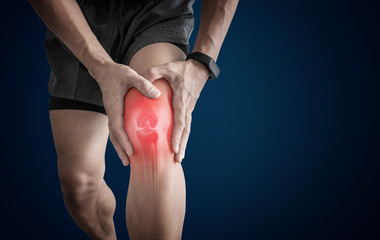Understanding Patellofemoral Pain Syndrome: Causes, Symptoms, and Treatment
Patellofemoral Pain Syndrome (PFPS), often referred to as “runner’s knee,” is a common condition characterized by pain in the front of the knee, around or behind the patella (kneecap). It affects people of all ages and activity levels, but it is particularly prevalent among athletes, especially those involved in running, jumping, or activities that require frequent knee movement. In this blog, we’ll explore the causes, symptoms, treatment options, and strategies for preventing PFPS, supported by research and expert insights.
What is Patellofemoral Pain Syndrome?
Patellofemoral Pain Syndrome (PFPS) is a broad term used to describe pain in the region where the patella meets the femur (thigh bone), typically around or behind the kneecap. It is not a single injury or diagnosis, but rather a cluster of symptoms related to the knee joint’s mechanics and the surrounding structures. PFPS can be caused by a variety of factors, including improper alignment of the patella, muscle imbalances, overuse, or injury.
Though the condition is often associated with athletes, it can also occur in non-athletes, particularly among those who engage in repetitive movements such as climbing stairs or squatting.
Causes of Patellofemoral Pain Syndrome
There is no single cause of PFPS, and it is usually the result of a combination of factors. Some of the most common causes include:
- Abnormal Patellar Tracking: The patella should glide smoothly within its groove at the end of the femur. In some individuals, the patella may not track properly during knee movement, leading to uneven pressure on the knee joint and resulting in pain (Crossley et al., 2001). This misalignment can occur due to structural issues such as a shallow femoral groove or imbalanced muscles.
- Weak or Tight Muscles: Weakness in the gluteus medius, can contribute to abnormal patellar tracking as it attaches into the iliotibial (IT) band to control knee stability. Additionally, tightness in the hamstrings or calves can affect knee mechanics, increasing the risk of PFPS (Tarsuslu et al., 2015).
- Overuse or Repetitive Stress: Repetitive activities that involve bending the knee, such as running, cycling, or jumping, can lead to overuse injuries. This constant stress can irritate the tissues around the patella, causing inflammation and pain (Powers, 2010).
- Foot Mechanics: Abnormalities in foot structure or gait, such as flat feet or overpronation (excessive inward rolling of the foot), can affect the alignment of the knee joint and lead to PFPS. Poor foot biomechanics can cause additional stress on the knee as the body compensates for these issues.
- Trauma or Injury: Direct trauma to the knee, such as a fall or a blow to the joint, can lead to PFPS. While this is less common than overuse-related causes, it can still result in pain and discomfort around the patella.
Symptoms of Patellofemoral Pain Syndrome
The hallmark symptom of PFPS is a dull, aching pain in the front of the knee, often described as being around or behind the patella. Common symptoms include:
- Pain During Activity: Activities that involve bending the knee—such as running, jumping, squatting, or climbing stairs—often exacerbate the pain.
- Pain After Prolonged Sitting: Individuals with PFPS may experience discomfort after sitting for long periods with their knees bent, a phenomenon known as “theater sign.”
- Knee Stiffness: The knee may feel stiff, particularly after periods of rest or after intense activity.
- Swelling: While less common, some individuals may experience mild swelling around the knee.
- Crepitus: A grinding or popping sensation may occur when the knee is moved, due to irregular patellar movement.
Treatment for Patellofemoral Pain Syndrome
The primary goals of PFPS treatment are to alleviate pain, restore normal patellar tracking, and improve overall knee function. Treatment options typically include:
- Rest and Activity Modification: The first step in managing PFPS is reducing activities that exacerbate the pain. This may include avoiding running, jumping, or prolonged sitting. Low-impact activities like swimming or cycling can help maintain fitness while reducing strain on the knee.
- Physical Therapy: A targeted physical therapy program is often the most effective way to treat PFPS. Therapy focuses on strengthening the gluteals, which helps stabilize the patella. Stretching exercises for tight muscles, such as the quadriceps and hamstrings, can also improve knee alignment and reduce stress on the joint (Powers, 2010).
- Ice and Anti-inflammatory Medications: Applying ice to the knee for 15–20 minutes several times a day can help reduce inflammation and relieve pain. Non-steroidal anti-inflammatory drugs (NSAIDs) like ibuprofen may also be used to manage symptoms, but they should only be taken under the guidance of a healthcare provider.
- Taping: Kinesiology tape can provide support and help guide the patella into proper alignment during activity. This can alleviate pain and prevent further irritation (Zhao et al., 2021).
- Footwear and Orthotics: Proper footwear that provides adequate arch support and cushioning can help address underlying foot mechanics that may contribute to PFPS. In some cases, custom orthotics may be recommended to correct issues such as overpronation.
Prevention of Patellofemoral Pain Syndrome
Preventing PFPS involves addressing the factors that contribute to the condition. Key strategies for prevention include:
- Strengthening Exercises: Focusing on strengthening the quadriceps and hip muscles can improve patellar tracking and prevent strain on the knee.
- Stretching and Flexibility: Regular stretching of the hamstrings, calves, and quadriceps can improve knee mechanics and reduce tension on the knee.
- Proper Technique: Learning proper techniques for activities like running, jumping, and squatting can reduce the risk of PFPS.
- Footwear: Wearing supportive shoes and using orthotics if necessary can help improve foot alignment and reduce stress on the knee.
Conclusion
Patellofemoral Pain Syndrome is a common yet treatable condition that can significantly impact an individual’s quality of life. Understanding the underlying causes, recognizing the symptoms, and following appropriate treatment and prevention strategies can help manage the condition effectively. With early intervention and proper care, most individuals with PFPS can return to their normal activities pain-free.
If you’re interested in physical therapy for your knee pain in Arizona, contact AzOPT today!
References
- Crossley, K. M., et al. (2001). Patellofemoral pain syndrome: a critical review of current concepts. Journal of Orthopaedic & Sports Physical Therapy, 31(8), 391-406.
- Powers, C. M. (2010). Patellofemoral pain syndrome: postural and movement impairments. Journal of Orthopaedic & Sports Physical Therapy, 40(6), 406-414.
- Tarsuslu, T., et al. (2015). The relationship between quadriceps strength and patellofemoral pain syndrome: A systematic review. Physiotherapy, 101(2), 139-147.
- Zhao, J., et al. (2021). The effects of patellar taping on pain and function in patients with patellofemoral pain syndrome: A systematic review and meta-analysis. Physiotherapy Theory and Practice, 37(10), 1221-1233.







